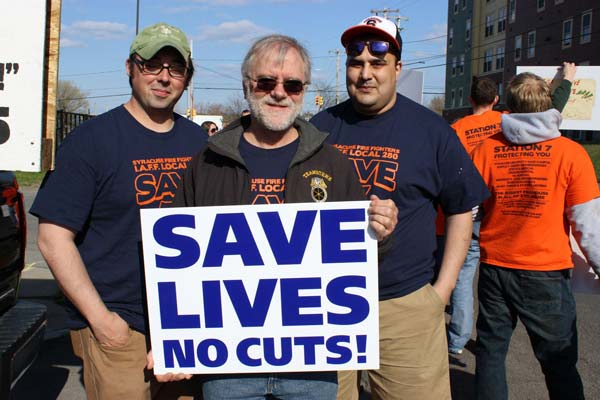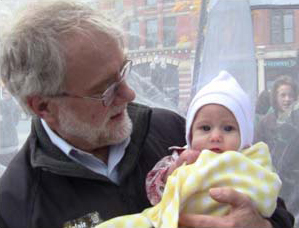Then to now
Share
Howie Hawkins shares his reflections on the Green Party

Howie Hawkins protesting with firefighters the closing of Fire Station 7 in Syracuse, NY. Photo by Ursula Rozum
The following are Howie Hawkins’ thoughts on the Green Party from his unique perspective as a founding member. For details on Hawkins’ role in the Green Party, see adjoining article.
What got you into being part of the start of the Green Party?
I have been committed to a third party of the people vs. the corporate rulers since 1964 when as a youth in California I witnessed the Republicans, led by spokesperson Ronald Reagan, conduct a successful referendum to repeal a fair housing law, and the Democrats seat the segregationist Dixiecrat delegation instead of the integrated civil rights Freedom Democrats delegation from Mississippi at the Democratic National Convention. The Democrats won in 1964 and escalated the war in Vietnam. So I campaigned for the Peace and Freedom Party in 1968, the People’s Party in 1972 and 1976, and the Citizens Party in 1980. In 1984, I was invited to participate in the first national Green Party organizing meeting in St. Paul, Minn. as a representative of the anti-nuclear Clamshell Alliance and I think Patch Adams, now Assistant Secretary of Health for Holistic Health in the Green Shadow Cabinet, and I are the only two left attending that meeting who are still alive and active in the Green Party.
What was it like in those early years?
It was sorting out process. Are we an independent party or a lobby on the major parties? How do we organize: as a grassroots confederation of local Green groups, as a staff-run NGO [non-governmental organization] funded by subscribers, or as a federation of strictly electoral state parties? What should be the relation of the Green movement to the Green Party? Are we an extension of the 60’s New Left into politics, bringing the issues the Old Left had neglected in its focus on class exploitation and economic justice back into the Left’s program: participatory democracy; oppression based on race, gender, and sexual orientation; the transclass issues of peace and ecology? Or were we beyond Left and Right, a completely new politics that history had nothing to teach? We had New Lefties, ecological anarchists, democratic socialists, bioregionalists, Georgist single taxers, libertarians, and non-ideological single-issue activists from peace, justice, and environmental movements? The arguments were sometimes acrimonious.
How is the Green Party different now?
The debate on our political independence is resolved. Those who were looking for instant success have fallen away. Those who remain are committed through the ups and downs of the long haul. The Left isn’t redbaited now and the Left is more open to a party of many tendencies united by political independence from the corporate power structure.
Is politics any different now from then?
30 more years of the two-party system of corporate rule failing to solve our society’s serious but solvable problems has expanded the public open to the Green Party alternative. The repeated failures of reform Democratic waves (Jesse Jackson, Howard Dean, Barack Obama) are sending political refugees to the Green Party. Where the Greens have organized a local base and consistently worked on the issues of concern to their communities; we have a legitimacy we didn’t have when we started organizing.
Is there anything you would do differently if you could restart the Green Party?
I would have spent less time in the national debates and political positioning in the 1980s and 1990s. I would have focused on building a well-organized, broadly based, and successful local and state party. That success would have set an example that spoke louder than all the endless mail, emails, and meetings we had debating but not convincing each other at the national level.
Any reflections?
After thirty years, I could write a book on this. But here is an outline of a talk I would like to give to Greens about what I’ve learned over those years.
Lessons we should learn:
- Organize, don’t just mobilize.
- Organize self-activity by working class people.
- Don’t just mobilize behind Greens.
- We need to organize a party framework where working people can discuss the issues and make their own decisions on policy and action.
- The leadership of middle class staff in grant-funded NGOs and unions has led to a passive working class and middle class sell outs.
- When working people are organized, speak and act for themselves collectively, they don’t sell out because they have nothing to gain as a class by selling out.
Mass membership Party
- Locals! Every Green should consistently participate in a local.
- The national should assist in the organizing of locals. We should aim for hundreds of thousands of activists organized into locals across the country.
- The state and national structures should be elected by members in locals who can hold them accountable, not by an atomized population or party registration voting (maybe) on self-nominated reps that get on state and national committees by petitions and primaries set up by the corporate state to disorganize us.
- Charge dues to finance the party. Our political independence is based on our financial independence.
Political Independence
- Not party patriotism, independent from all other parties. We may find allies coming out of other movements, as the Green Rainbow Party of MA and Statehood Green Party of DC did. We should be open to merging with new movements coming out of the socialist, labor, black, and Latino movements into a broader independent party.
- Our definition of political independence should be class independence from the corporate rulers and their political representatives in the Democratic and Republican parties.
Class Analysis
- We basically have a three-class society: working class; professional-managerial middle class; and ruling class.
- The ruling class rules by dividing and demoralizing the working class and winning over most of the middle class.
- Organize a party framework that brings the four, mutually suspicious sectors of the working class together around common interests: unionized corporate sector, unionized public sector, non-union competitive sector, administered welfare and prison sector.
- Organize to bridge the growing racial and class segmentation of our society.
- Prioritize organizing the most oppressed. If not centrally involved, they are neglected: racism has been the Achilles heel that has so far defeated all historical American progressive movements from within.
Learn to Debate and Educate
- Consensus culture avoids open debate. Consensus-seeking has its place, but we must learn to use Robert’s Rules, a revolutionary manual for democracy that distills the American experience in deliberative democracy.
- Learn to put our differences on the table and have an open, honest debate.
- Political education should be a priority for locals. We can’t leave policy to a few wonks. We can’t afford to repeat mistakes we could avoid by knowing history.
For more information about Howie Hawkins and his 2014 campaign for New York Governor go to www.howiehawkins.org





